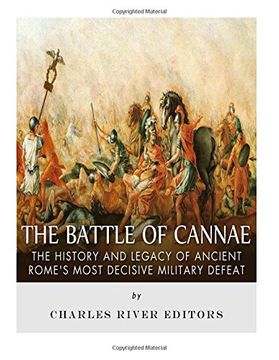The Battle of Cannae: The History and Legacy of Ancient Rome’S Most Decisive Military Defeat (en Inglés)
Reseña del libro "The Battle of Cannae: The History and Legacy of Ancient Rome’S Most Decisive Military Defeat (en Inglés)"
*Includes pictures *Includes ancient accounts of the battle *Includes online resources and a bibliography for further reading *Includes a table of contents "Few battles of ancient times are more marked by ability...than the battle of Cannae. The position was such as to place every advantage on Hannibal's side. The manner in which the far from perfect Hispanic and Gallic foot was advanced in a wedge in échelon...was first held there and then withdrawn step by step, until it had reached the converse position...is a simple masterpiece of battle tactics. The advance at the proper moment of the African infantry, and its wheel right and left upon the flanks of the disordered and crowded Roman legionaries, is far beyond praise. The whole battle, from the Carthaginian standpoint, is a consummate piece of art, having no superior, few equal, examples in the history of war." - Theodore Dodge, military historian Although the Romans gained the upper hand over Carthage in the wake of the First Punic War, the legendary Carthaginian general Hannibal brought the Romans to their knees for over a decade during the Second Punic War. While military historians are still amazed that he was able to maintain his army in Italy near Rome for nearly 15 years, scholars are still puzzled over some of his decisions, including why he never attempted to march on Rome in the first place. Regardless, Hannibal was such a threat that the Romans responded in an unprecedented nature when the Carthaginians resumed the campaigning season in the spring of 216 BCE by capturing the city of Cannae, a crucial supply hub, and placing themselves along the line that convoys from the ports and warehouses of the south needed to travel to reach Rome. This was something the Romans could not and did not take lying down; Rome raised the largest army in their city's history, a force of between 80,000 and 100,000 men, and marched south with Consuls Varro and Paullus at the head of the army. This military behemoth disregarded the delaying tactics that Maximus had favored, fully determined to destroy Hannibal once and for all as quickly as possible. Despite the massive horde headed his way, Hannibal was ready for them. He encamped his army near the Aufidus, a river not far from Cannae, and waited. His intelligence told him that Consul Varro, the more influential of the two Roman generals, was a firebrand, talented in attack but with a tendency to overreach himself, and Hannibal resolved to use this flaw to his advantage. Hannibal arrayed his army in the open, sure that Varro would be unable to resist the temptation to offer battle, and then deliberately placed his weakest infantry in the center of his battle-line. Varro led the Roman legions straight at the centre of Hannibal's formation, proceeding in characteristic bull-headed fashion and spearheading the assault himself. Hannibal's troops in the center yielded before the legions, as Hannibal had anticipated, sucking the bulk of the Roman force deep into the centre of Hannibal's formation. Meanwhile, the wings of Hannibal's infantry automatically swung against the flanks of the Roman force while Hannibal's cavalry, led by his celebrated general Maharbal, crushed the Roman cavalry and light infantry deployed to protect the formation's flanks and rear and, in so doing, succeeded in encircling it completely. The Roman force now found itself unable to run or maneuver, completely surrounded by Hannibal's forces. It was one of the earliest examples of the pincer movement in the history of warfare. The result was a massacre, one of the most vicious battles in the history of the world. Around 75% of the Roman army was cut down in the ensuing melee, which would be in the vicinity of between 50,000-80,000 soldiers depending on which initial estimates are considered to be accurate. Among the casualties was the luckless Consul Paullus.

